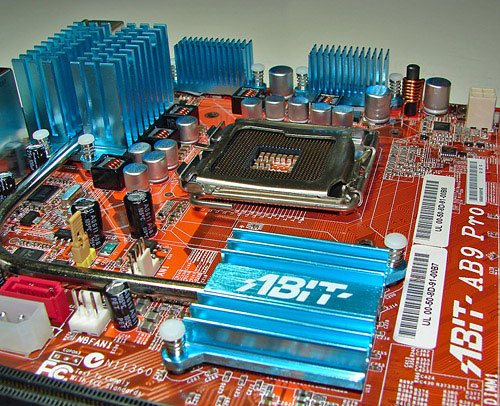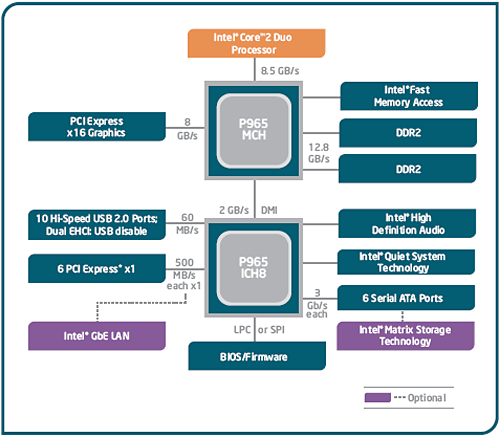Abit AB9 Pro: A sneak peek at Intel's new P965 chipset
by Gary Key on July 3, 2006 3:45 AM EST- Posted in
- Motherboards
As we mentioned in our Computex 2006 coverage, the rejuvenation of Abit was one of the more welcome surprises of the show. Abit was the top manufacturer of enthusiast level boards just a few short years ago and catered almost exclusively to the overclocking community. However, Abit found itself in serious trouble over the past couple of years as its product portfolio expanded to include video cards and a wide range of motherboards from the low end value segment to the upper end enthusiast sector. In essence, Abit tried to expand into areas where it did not have the manufacturing expertise or cost advantages to compete with the larger tier one manufacturers. As a result, Abit lost focus on its core competence, the enthusiast and overclocking market, and allowed DFI to become the number one brand name in an area where users are highly passionate about their products.

Toward the end of 2005, Abit was close to ceasing business operations as their product lines did not offer any real price, performance, or product differentiation from others except for their µGuru technology. Fortunately, Abit entered into a long-term partnership with USI this past January that ensures their financial health for the future and a change in the company name. Universal Abit is the successor to the Abit motherboard brand and has partnered with USI for their manufacturing and engineering expertise.
The Abit name will remain as the main identity for products but expect to hear more from Universal Abit as the company transitions itself from strictly IT manufacturing to leading technology design and brand management. This strategic partnership also signals a return of Abit to their roots as a company driven to provide the computer enthusiast and extreme overclocker with the highest performance solutions available. While we have not received their new Max or Fatal1ty product lines for review yet, Abit was generous enough to send us their mainstream Intel performance board -- the AB9 Pro -- based upon the new Intel P965 Express chipset.

Intel released the P965 Express MCH and ICH8/R chipsets during Computex 2006. While we will take a closer look at this new mainstream chipset in future articles, the highlights of the P965 MCH include Intel's new Fast Memory Access technology, 1066MHz front side bus support, 800MHz DDR-2 memory support, and full support for the new Core 2 Duo processor lineup. The integrated graphics versions, G965 and Q965, will ship with the new GMA X3000 graphics engine for the ViiV and Corporate markets respectively. The new ICH8/R chipsets offer ten USB 2.0 ports, up to six 3Gb/s SATA ports, Intel's new Quiet System Technology, and the removal of Parallel ATA support.
While one could argue that the removal of PATA support is a needed step forward in technology, we firmly believe that Intel should have waited until the next generation ICH for this change. The Optical Drive market is still about 98% PATA based and does not seem to be changing anytime soon. While this development might spur the optical drive suppliers into offering additional SATA drives in the near future, it does not address the requirements of the current PATA installed base. This most likely means there will be additional costs and complexity on the motherboards using ICH8 as the manufacturers will have to add an additional chipset for PATA support. (Manufacturers could simply choose not have any PATA ports, but at present we feel such a motherboard would be doomed to fail.)
Abit will be one of the first manufacturers to market with a P965 based board and we will take a quick but strictly preview look at the AB9 Pro today. While this motherboard is a production release unit, the BIOS is still undergoing almost daily revisions at this time. We will state at this point that our current BIOS release offers significant functionality, very good base performance, but will not yet allow us to change memory speeds or timings. Please keep this in mind as you compare the performance results against our Asus 975X based board. We will give this board a more in depth review during our forthcoming Intel Core 2 Duo motherboard roundup. Let's see what this board has to offer at this time.

Toward the end of 2005, Abit was close to ceasing business operations as their product lines did not offer any real price, performance, or product differentiation from others except for their µGuru technology. Fortunately, Abit entered into a long-term partnership with USI this past January that ensures their financial health for the future and a change in the company name. Universal Abit is the successor to the Abit motherboard brand and has partnered with USI for their manufacturing and engineering expertise.
The Abit name will remain as the main identity for products but expect to hear more from Universal Abit as the company transitions itself from strictly IT manufacturing to leading technology design and brand management. This strategic partnership also signals a return of Abit to their roots as a company driven to provide the computer enthusiast and extreme overclocker with the highest performance solutions available. While we have not received their new Max or Fatal1ty product lines for review yet, Abit was generous enough to send us their mainstream Intel performance board -- the AB9 Pro -- based upon the new Intel P965 Express chipset.

Intel released the P965 Express MCH and ICH8/R chipsets during Computex 2006. While we will take a closer look at this new mainstream chipset in future articles, the highlights of the P965 MCH include Intel's new Fast Memory Access technology, 1066MHz front side bus support, 800MHz DDR-2 memory support, and full support for the new Core 2 Duo processor lineup. The integrated graphics versions, G965 and Q965, will ship with the new GMA X3000 graphics engine for the ViiV and Corporate markets respectively. The new ICH8/R chipsets offer ten USB 2.0 ports, up to six 3Gb/s SATA ports, Intel's new Quiet System Technology, and the removal of Parallel ATA support.
While one could argue that the removal of PATA support is a needed step forward in technology, we firmly believe that Intel should have waited until the next generation ICH for this change. The Optical Drive market is still about 98% PATA based and does not seem to be changing anytime soon. While this development might spur the optical drive suppliers into offering additional SATA drives in the near future, it does not address the requirements of the current PATA installed base. This most likely means there will be additional costs and complexity on the motherboards using ICH8 as the manufacturers will have to add an additional chipset for PATA support. (Manufacturers could simply choose not have any PATA ports, but at present we feel such a motherboard would be doomed to fail.)
Abit will be one of the first manufacturers to market with a P965 based board and we will take a quick but strictly preview look at the AB9 Pro today. While this motherboard is a production release unit, the BIOS is still undergoing almost daily revisions at this time. We will state at this point that our current BIOS release offers significant functionality, very good base performance, but will not yet allow us to change memory speeds or timings. Please keep this in mind as you compare the performance results against our Asus 975X based board. We will give this board a more in depth review during our forthcoming Intel Core 2 Duo motherboard roundup. Let's see what this board has to offer at this time.










33 Comments
View All Comments
mechBgon - Thursday, July 6, 2006 - link
Peak. A summit, a maximum value, etc.Peek. A quick look, a glance.
Pique. Annoyance, such as some people experience when "peak" and "peek" get swapped in full view of 2-3 million people. ;)
That is all. We now return you to your regularly-scheduled DailyTech program. :)7
JarredWalton - Saturday, July 8, 2006 - link
It just looked so nice right next to "sneak". We were debating between a "sneek peek", a "sneak peak", and a "snique pique" and you can see which one got the vote. ;)Sorry for the error - proofing thousands of words per week, stuff does slip through occasionally. On the bright side, we can fix the errors as they're caught - revisionist publishing at its best.
zsdersw - Thursday, July 6, 2006 - link
Pique can also mean to provoke or arouse.. as in: "His flashy outfit piqued my interest."commonuser - Thursday, July 6, 2006 - link
good review. particularly so as i've become increasingly interested in the direction these new platforms will take.however, i must say that i'm finding the obsession with SLI/Crossfire a bit overemphasized in every motherboard review i've read on the web as of late. now, i really do not have the exact figures at my disposal, but i'd say with a pretty high level of assumptive confidence that a significantly lower proportion of so-called "enthusiast" cyberpopulace makes use of these solutions, compared to traditional, albeit powerful single-gpu setup (think x1900xtx, or 7900gtx). "mainstream" segment falls into a non-SLI/CF category even more so...
therefore, when we have this opening sentence: , and this sentence in the conclusion: , one has to ask him/herself: what really is the difference among "enthusiast", "mainstream", "value", and/or "entry-level" chipsets and mainboards? is it soon going to be a huge oversight or a mistake if a manufacturer leaves out SLI support on a "value" or "entry-level" MB?
JarredWalton - Saturday, July 8, 2006 - link
Note the criticism is directed at *Intel* for not allowing manufacturers to make 2x8 PCIe configurations using P965. Given the cost of making that change, I would much rather have the option of using SLI/CF even if I never take advantage of it. One PCIe X16 slot is pretty much "value oriented" in my opinion these days.Kiste - Thursday, July 6, 2006 - link
Is it even possible to install WinXP from a PATA drive if the PATA port is 3rd party?I just bought a very nice BenQ PATA DVD writer and I certainly won't get rid of it just to buy Plextor's crappy SATA DVD writer or the even more abysmal one from Samsung.
Gary Key - Thursday, July 6, 2006 - link
Yes, there is limited functionality in the bios that allows the system to recognize the PATA port upon boot and for it to be utilized to load the OS or drivers if the OS is already loaded. We have seen this operation on our first two 965 boards but have one board that would not allow the PATA port to be recognized until the drivers were loaded. We were told this would be corrected in the shipping bios.goinginstyle - Tuesday, July 11, 2006 - link
Is it possible to load Linux with this IDE controller?Kiste - Thursday, July 6, 2006 - link
Ok, I'm not sure I completely understand. I can boot up with my WinXP installation CD and then I'll have to install drivers for the 3rd party PATA controller before I can install WinXP? Is that about right? Does that mean that I need a floppy drive?JarredWalton - Saturday, July 8, 2006 - link
If the BIOS is designed correctly, it can make the base XP installation detect the 3rd party IDE without drivers. Some earlier IDE chipsets didn't work (back in nF3 and ealier time frame), but most IDE and SATA solutions will now work without a driver disk. You would still need the driver disk for RAID, and certain BIOS settings might require it as well.